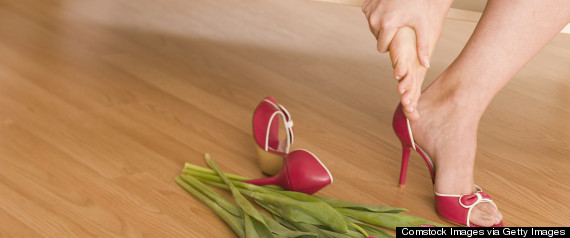If you wore a pedometer from the day you started walking, you’d have logged in more then 70,000 miles by the time you hit age 50. When you walk a good portion of those miles in improperly-fitting shoes or otherwise neglect your feet, it’s little wonder why they hurt.
The 38 muscles in your feet make up approximately 25 percent of the muscles in your body and absorb 1,000 pounds of force each day. Bad foot health habits can quickly add up to major problems. Below, experts discuss the most common bad habits, the consequences and ways to fix your feet so they carry you through your next 50 years:
1. You follow the barefoot running fad. The recent trend toward minimalist running shoes or barefoot running can be problematic for those who’ve been running in supportive shoes for many years, says Dr. Sherri Greene, a New York podiatrist. “Since most people don’t train to strengthen their feet, I find many have very weak muscles and tendons. And it’s not a good idea if you have biomechanically-challenged feet (e.g. flat feet) or neuropathy.”
Greene recommends wearing supportive shoes or, if you’re hooked on the idea of barefoot running, train to strengthen your feet where they may tolerate a minimal shoe.
2. You skip socks. Sticking your bare feet into a pair of shoes creates a field day for fungus, says Greene. Shoes such as Uggs made the news recently when the dark, cozy boot interior was found to trigger fungal infections in people who wore them sans socks.
“Fungus thrives in dark and moist environments,” says Greene. Since the bug can survive long periods of time in your shoes, you also risk re-infecting yourself even if you initially clear up the problem, she adds. “Avoid the risk altogether and always wear socks.”
3. You’re a woman and love high heels.
Wearing heels for special occasions won’t do much harm, says Dr. Andrew Gerken, foot/ankle specialist and orthopedic surgeon with Hoag Orthopedic Institute in Irvine, Calif. “As long as you don’t wear them all day long at work every day. Then it’s not a good idea, especially if they’re pointy toe shoes,” he notes.
The downward pressure on top of the scrunched toe box can cause bunions and often surgery is needed to realign the toe, says Gerken. “Heredity is also a factor for bunions. They can also recur if you continue wearing pointy toe shoes after surgery.”
4. You can’t remember the last time you replaced your running shoes.Your worn out, comfy running shoes may be like old friends, but old shoes lose shock absorption and support over time. “Running in them can contribute to injury (e.g. plantar fasciitis, inflammation of a tendon that runs along the bottom of the foot). But there’s no good metric to figure out when it’s time to replace your shoes,” says Gerken.
He notes general rules of thumb include replacing shoes every 300 miles, or approximately every four months, but recommends using common sense as your guide. “Ask yourself, how do my shoes look and feel?” says Gerken.
5. You do too much too soon. Overdoing a high-impact sport, like running, can cause injuries, such as Achilles problems. “Often it’s a problem of too much too soon,” Gerken says. This typically happens to new runners or runners returning to the sport after an injury.
Runners who refuse to crosstrain (alternate biking or other non-impact sport along with running) are at high risk. “It’s not a good idea to ‘only’ want to run,” Gerken says. If you become injured, Gerken recommends recognizing problems early and then working with your podiatrist or trainer to develop a “game plan” to get you back on track, which may include extra stretching and a step-by-step program to get you back in the game safely.
6. You wear flip flops everywhere.

Although they’ve become practically the official shoe of summer, flip flops offer little support and can put you at risk for a number of foot injuries. Gripping the shoe with your toes to make sure they don’t slide out when you walk can throw off your gait and increase your risk of tripping and falling.
In addition, muscle strains can result from rolling and twisting yourself off the shoe, since they do not contain an ankle strap for support. An athletic shoe or a flip flop with an orthotic foot bed make better options.
7. You’re a woman who lives in ballet flats.
Many of the same problems found in flip flops pertain to ballet flats, as they offer no arch support, says Dr. Dominic J. Catanese, a podiatric surgeon at Montefiore Medical Center in New York. “They have no cushioning or support, which can lead to heel pain, plantar fasciitis and pain under the ball of the foot.”
Those without foot problems or pain may be able to wear them, but otherwise choose sandals with a contoured arch and a heel cup, suggests Catanese.
